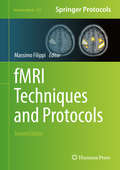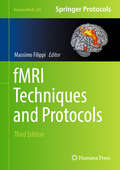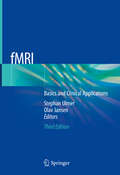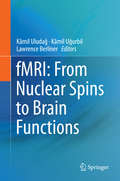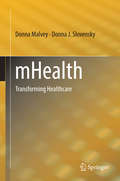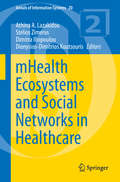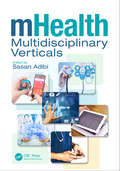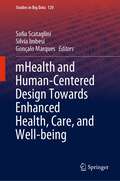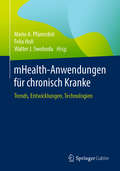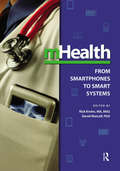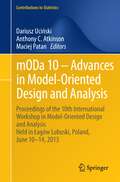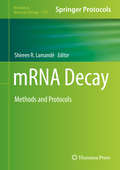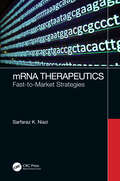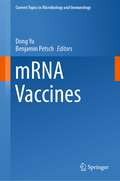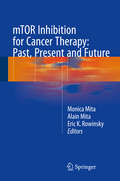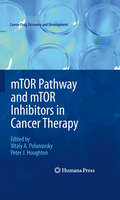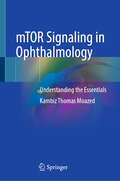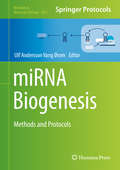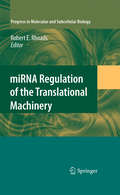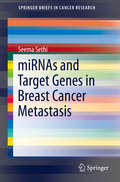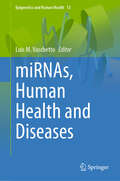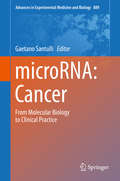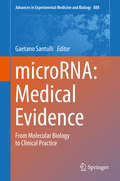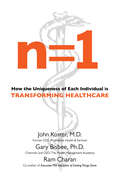- Table View
- List View
fMRI Techniques and Protocols
by Massimo FilippiAs fMRI technology has provided invaluable insights into the mechanisms through which the human brain works in healthy individuals and in patients with different neurological and psychiatric conditions, the study of brain function and even the monitoring of the effects of treatment have become more effective and efficient. In fMRI Techniques and Protocols, an international assemblage of renowned scientists and physicians provide the background needed to plan and design new studies in order to advance our knowledge of the physiology of the normal human brain and its change following tissue injury. With sections focusing on basic principles of fMRI, its application to measure brain function, clinical applications, and glimpses into the future of fMRI development, the volume condenses this ample, varied field into one user-friendly compendium of information and techniques. Comprehensive and cutting-edge, fMRI Techniques and Protocols is an ideal guide for all those who wish to continue expanding this dynamic and ever-growing field of research.
fMRI Techniques and Protocols (Neuromethods #220)
by Massimo FilippiThis third edition volume expands on the previous edition with updates on the latest methodological aspects of fMRI and achievements made through the applications to the study of central nervous system functioning in the clinical field. The chapters in the book are organized in four parts: Part One talks about the basic knowledge for the understanding of the technical aspects of fMRI. Part Two describes the main findings obtained from the application of fMRI to study brain system function of healthy individuals. Part Three explores clinical findings obtained from the use of fMRI to assess the role of brain plasticity in major neurological and psychiatric conditions. Part Four presents novel approaches for the integration of fMRI data with measures of damage assessed using structural MR techniques and the use of fMRI to image spinal cord function. In the Neuromethods series style, chapters include the kind of detail and key advice from the specialists needed to get successful results in your laboratory.Cutting-edge and comprehensive, fMRI Techniques and Protocols, Third Edition provides clinicians and researchers with a &“user-friendly&” summary of the field, and helps them plan and carry out successful studies.
fMRI: Basics and Clinical Applications
by Stephan Ulmer Olav JansenThis book, now in its revised and updated third edition, provides a state of the art overview of fMRI and its use in clinical practice. Experts in the field share their knowledge and explain how to overcome diverse potential technical barriers and problems. Starting from the very basics on the origin of the BOLD signal, the book covers technical issues, anatomical landmarks, methods of statistical analysis, and special issues in various clinical fields. Comparisons are made with other brain mapping techniques and their combined use with fMRI is also discussed. Existing chapters have been updated and new chapters have been added in order to account for new applications, further clinical fields and methods, e.g. resting state fMRI. Based on the clinical focus, this book will be of great value for Neuroradiologists, Neurologists, Neurosurgeons but also Researchers in Neuroscience.
fMRI: From Nuclear Spins to Brain Functions
by Lawrence Berliner Kâmil Uludağ Kâmil UğurbilThis volume explores the revolutionary fMRI field from basic principles to state-of-the-art research. It covers a broad spectrum of topics, including the history of fMRI's development using endogenous MR blood contrast, neurovascular coupling, pulse sequences for fMRI, quantitative fMRI; fMRI of the visual system, auditory cortex, and sensorimotor system; genetic imaging using fMRI, multimodal neuroimaging, brain bioenergetics and function and molecular-level fMRI. Comprehensive and intuitively structured, this book engages the reader with a first-person account of the development and history of the fMRI field by the authors. The subsequent sections examine the physiological basis of fMRI, the basic principles of fMRI and its applications and the latest advances of the technology, ending with a discussion of fMRI's future. fMRI: From Nuclear Spins to Brain Function, co-edited by leading and renowned fMRI researchers Kamil Ugurbil, Kamil Uludag and Lawrence Berliner, is an ideal resource for clinicians and researchers in the fields of neuroscience, psychology and MRI physics.
le Psychiatric Power Lectures at the Collège de France, 1973-1974
by Michel Foucault Graham Burchell Arnold I. Davidson Alessandro Fontana Jacques Lagrange Francois EwaldIn this new addition to the Coll#65533;ge de France Lecture Series Michel Foucault explores the birth of psychiatry, examining Western society's division of 'mad' and 'sane' and how medicine and law influenced these attitudes. This seminal new work by a leading thinker of the modern age opens new vistas within historical and philosophical study.
mHealth
by Donna Malvey Donna J. SlovenskyThis book defines the phenomenon of mHealth and its evolution, explaining why an understanding of mHealth is critical for decision makers, entrepreneurs and policy analysts who are pivotal to developing products that meet the collaborative health information needs of consumers and providers in a competitive and rapidly-changing environment. The book examines trends in mHealth and discusses how mHealth technologies offer opportunities for innovators and entrepreneurs, those who often are industry first-movers with regard to technology advancement. It also explores the changing dynamics and relationships among physicians, patients, insurers, regulators, managers, administrators, caregivers and others involved in the delivery of health services. The primary focus is on the ways in which mHealth technologies are revising and reshaping healthcare delivery systems in the United States and globally and how those changes are expected to change the ways in which the business of healthcare is conducted. mHealth: Transforming Healthcare consists of nine chapters that addresses key content areas, including history (to the extent that dynamic technologies have a history), projection of immediate evolution and consistent issues associated with health technology, such as security and information privacy and government and industry regulation. A major point of discussion addressed is whether mHealth is a transient group of products and a passing patient encounter approach, or if it is the way much of our health care will be delivered in future years with incremental evolution to achieve sustainable innovation of health technologies.
mHealth Ecosystems and Social Networks in Healthcare
by Athina A. Lazakidou Stelios Zimeras Dimitra Iliopoulou Dionysios-Dimitrios KoutsourisThis book provides a principled approach to classification using the available data in a model which combines information from the social network and the healthcare models. It presents studies from leading researchers and practitioners focusing on the current challenges, directions, trends and opportunities associated with healthcare delivery systems and their supporting wireless and mobile health technologies. mHealth Ecosystems and Social Networks in Healthcare is divided into two parts. Part I covers the area of mHealth Ecosystems. Chapters include topics on adoption of cloud based mHealth services, the socio-economic impact of mHealth, as well as self-management of health and disease. In Part II, Social Networks in Healthcare are highlighted. Chapters cover social media and patient support, virtual knowledge sharing and knowledge management and also web-based applications in health care. Ultimately this book is an excellent source of comprehensive knowledge and literature on the topics of mobile health ecosystems and social networks in healthcare.
mHealth Multidisciplinary Verticals
by Sasan AdibiAn in-depth overview of the emerging concept; Mobile Health (mHealth), mHealth Multidisciplinary Verticals links applications and technologies to key market and vendor players. It also highlights interdependencies and synergies between various stakeholders which drive the research forces behind mHealth. The book explores the trends and directions w
mHealth and Human-Centered Design Towards Enhanced Health, Care, and Well-being (Studies in Big Data #120)
by Sofia Scataglini Gonçalo Marques Silvia ImbesiThe book examines the current state of mHealth and Human-Centered Design (HCD) initiatives toward health, care, and well-being. The present surge in interest in improving people's quality of life is creating new prospects for the development of innovative design solutions aimed at enhancing living conditions. The combination of emerging user needs and opportunities provided by recent innovative mHealth technologies enables research institutions, stakeholders, and academia to design new solutions to promote well-being, health, and care, thereby improving the quality of life of people of all ages. The book analyzes and discusses the most innovative services, products, and systems in the healthcare field. This strategy is in line with the concept of ambient assisted living or enhanced living environment, which focuses on the comfort and health of specific categories of users.This book covers several topics highlighting the importance of involving end-users in the design of innovative solutions in digital health care, and design considerations of mobile healthcare applications.Furthermore, the covered topics are described in their current applications in relevant fields focusing on the design of smart solutions, such as biomonitoring systems, activity recognition tools, smart living environments, physical autonomy, and virtual assistance.This editorial project is addressed to academics, designers, engineers, and practitioners in health care who want to promote cooperation between academia, stakeholders, and research institutions.
mHealth-Anwendungen für chronisch Kranke: Trends, Entwicklungen, Technologien
by Mario A. Pfannstiel Felix Holl Walter J. SwobodaDie Digitalisierung im Gesundheitsmarkt verändert und erweitert die Möglichkeiten Menschen mit chronischen Erkrankungen zu helfen, weshalb sie einen immer größeren Stellenwert für Diagnostik und Versorgung einnimmt. Der Sammelband gibt einen Überblick über neueste, innovative mHealth-Lösungen, die als tägliche Begleiter bei Prävention, Diagnostik und Therapie zum Einsatz kommen. Praxisbeispiele zeigen Entwicklungen und die Inanspruchnahme von mHealth-Anwendungen durch Patienten und klinisches Personal auf und es werden zahlreiche für die Forschung relevante Fragen behandelt. Damit richtet sich dieses Buch sowohl an Ärzte, Patienten, Entwickler und weitere Praktiker, die Mobile-Health-Anwendungen nutzen und zur Weiterentwicklung beitragen sowie an Wissenschaftler und Dozenten mit den Schwerpunktfächern Gesundheitsmanagement, Informationstechnologie und Medizin.
mHealth: From Smartphones to Smart Systems (HIMSS Book Series)
by Mas, Metcalf David Rick Krohn Ma, Mas, Metcalf David Rick Kroh MamHealth: From Smartphone to Smart Systems provides a high level and comprehensive survey of the emergence of mobile technology healthcare. This book looks beyond the already-popular devices and apps associated with mHealth, exploring the major role this technology could play as healthcare steers inexorably toward an architecture
mODa 10 – Advances in Model-Oriented Design and Analysis
by Maciej Patan Dariusz Ucinski Anthony C. AtkinsonThis book collects the proceedings of the 10th Workshop on Model-Oriented Design and Analysis (mODa). A model-oriented view on the design of experiments, which is the unifying theme of all mODa meetings, assumes some knowledge of the form of the data-generating process and naturally leads to the so-called optimum experimental design. Its theory and practice have since become important in many scientific and technological fields, ranging from optimal designs for dynamic models in pharmacological research, to designs for industrial experimentation, to designs for simulation experiments in environmental risk management, to name but a few. The methodology has become even more important in recent years because of the increased speed of scientific developments, the complexity of the systems currently under investigation and the mounting pressure on businesses, industries and scientific researchers to reduce product and process development times. This increased competition requires ever increasing efficiency in experimentation, thus necessitating new statistical designs. This book presents a rich collection of carefully selected contributions ranging from statistical methodology to emerging applications. It primarily aims to provide an overview of recent advances and challenges in the field, especially in the context of new formulations, methods and state-of-the-art algorithms. The topics included in this volume will be of interest to all scientists and engineers and statisticians who conduct experiments.
mRNA Decay: Methods and Protocols (Methods in Molecular Biology #1720)
by Shireen R. LamandéThis detailed volume explores the latest methods that can be used to probe mRNA decay pathways and identify mRNA-binding protein targets as well as miRNA targets. Subjects include metabolic labelling and RNAseq methods for determining RNA decay rates, approaches for discovering RNA-binding protein targets, bioinformatics, miRNA targets and novel components of the miRNA-directed decay pathway, and recently developed approaches for studying nonsense-mediated mRNA decay, among other areas. Written for the highly popular Methods in Molecular Biology series, chapters include introductions to their respective topics, lists of the necessary materials and reagents, step-by-step, readily reproducible laboratory protocols, and tips on troubleshooting and avoiding known pitfalls. Authoritative and practical, mRNA Decay: Methods and Protocols serves as an ideal guide for molecular biologists, geneticists, and developmental biologists with an interest in understanding how normal development and tissue homeostasis is regulated and how these processes are perturbed in inherited and acquired diseases.
mRNA Therapeutics: Fast-to-Market Strategies
by Sarfaraz K. NiaziThis book is the most comprehensive and complete treatise on nucleic acid therapeuticproducts, including mRNA vaccines, their manufacturing, formulations, andtesting for safety and efficacy. Details include cGMP-compliant manufacturing andregulatory filing steps. A new concept of “biosimilar” mRNA vaccine is presentedto secure fast approval of copies of mRNA vaccines. Projections of financial plansto establish RNA manufacturing facilities are provided, along with details of supplychain management. Finally, the future of nucleic acid products in gene therapy andother newer applications is presented, along with a perspective that all new vaccineswill be the nucleic acid type that will further provide first-time prevention of autoimmunedisorders. It is projected that both big pharma and start-ups will enter this field,and we can expect significant additions to our drug armamentarium soon.
mRNA Vaccines (Current Topics in Microbiology and Immunology #440)
by Dong Yu Benjamin PetschThe formulation and the technological advancements in RNA biology, chemistry, stability, and encapsulated delivery systems that have enabled the development of fully synthetic mRNA vaccines are discussed in this volume. The applications of the mRNA technology is covered, focusing on infectious diseases but also touching on other indications, such as immunotherapies and molecular therapies. Potent and long-lasting immune responses observed in animal models, encouraging data from early human clinical studies, together with the success of two mRNA-based COVID-19 vaccines support the use of mRNA-based vaccination as an attractive alternative to conventional vaccine approaches. Consequently, the development progress of the technology, particularly on production, capabilities, and clinical development is reviewed. Topics on safety, regulatory issues, and possible challenges to the mRNA vaccination approach round off this book. Thanks to their high potency, the prospect for generic, low-cost manufacturing processes, and entirely synthetic nature, the future for mRNA vaccines is highly promising. Importantly, mRNA vaccines have the potential to minimize the time between pathogen identification and vaccine release with a huge impact on public health. As the mRNA-based vaccination technology has been progressing rapidly, the book is intended to be an end-to-end review series, covering everything from basic RNA biology and preclinical studies to the manufacturing strategy, clinical development and regulatory approval. It provides established RNA researchers and developers with updates on the latest advancements in the field and allows for a quick but comprehensive overview of this transformative technology, its application, and future potential.
mTOR Inhibition for Cancer Therapy: Past, Present and Future
by Monica Mita Alain Mita Eric K. RowinskyThis book describes the challenges involved in developing mTOR inhibitors for cancer treatment, starting with an in-depth examination of their molecular mechanism of action, with emphasis on the class side-effects, efficacy and mechanisms of resistance, as well as on promising novel directions for their development, including novel compounds and rational combinations with other anti-neoplastic drugs. Over the last 10 years, inhibitors of mTOR have emerged as a major class of anticancer drugs. Two rapamycin analogs are currently approved for the treatment of renal cell carcinoma, and it is estimated that a variety of other tumor types could benefit from mTOR inhibition, with numerous clinical trials (including pivotal registration trials) already underway. Second-generation small-molecule inhibitors of the pathway have also shown promise in terms of their superior tolerability and efficacy and are undergoing extensive clinical evaluation, with an estimated 30+ compounds currently under evaluation.
mTOR Pathway and mTOR Inhibitors in Cancer Therapy
by Peter J. Houghton Vitaly A. PolunovskymTOR Pathway and mTOR Inhibitors in Cancer Therapy provides an up-to-date survey of the rapidly advancing field of cancer therapy. Our understanding of the mechanisms involved in cancer genesis and progression underwent unprecedented expansion during the last decade, opening a new era of cancer treatment – targeted therapy. The surge in this area results in no small part from studies conducted jointly by basic health scientists and clinical investigators. It is our hope that this book will help foster even further collaboration between investigators in these two disciplines. In this work, experts in TOR signaling have contributed in two thematic areas: mTOR Signaling and Cancer Therapy (chapters 1 - 8) and Therapeutic Targeting Downstream of mTOR (chapter 9 – 13). All chapters of mTOR Pathway and mTOR Inhibitors in Cancer Therapy are completely new or have been extensively updated by their authors; and we are indebted to all authors who have exemplified the links between these 2 thematic areas.
mTOR Signaling in Ophthalmology: Understanding the Essentials
by Kambiz Thomas MoazedThe mammalian target of rapamycin (mTOR) is a central node in cell regulation, impacting everything from cellular growth and metabolism to the intricate mechanisms of aging and disease. Its role in the eye, however, is an emerging field that promises to revolutionize our understanding of ocular health and disease. This book discusses the role of mTOR signaling in the eye. It aims bridge the gap between deep molecular biology and clinical ophthalmology by focusing on the profound effects of mTOR signaling in various parts of the eye. The initial chapters of this book lay the foundational knowledge necessary to understand the complex biology of mTOR, followed by the specific effects on each individual parts of the eye. This book is written for researchers, clinicians, and students who are part of a multidisciplinary team striving to push the boundaries of ocular research into mTOR pathways. By the end of this journey, readers will have a comprehensive understanding of the multifaceted roles of mTOR in the eye and the brain, equipped with the knowledge to translate these insights into innovative treatments for ocular and neurodegenerative diseases.
miRNA Biogenesis: Methods and Protocols (Methods in Molecular Biology #1823)
by Ulf Andersson ØromThis detailed volume collects chapters that seek to expand our knowledge of molecular events and extended molecular networks in gene regulation. The contents explore numerous aspects of miRNA biogenesis, a sophisticated series of events that assure a finely tuned regulation of miRNA expression and activity. Written for the highly successful Methods in Molecular Biology series, chapters include introductions to their respective topics, lists of the necessary materials and reagents, step-by-step readily reproducible laboratory protocols, and tips on troubleshooting and avoiding known pitfalls. Authoritative and practical, miRNA Biogenesis: Methods and Protocols aims to contribute to the further development of knowledge and application of miRNA biogenesis, both in the basic research lab and in the clinic.
miRNA Regulation of the Translational Machinery
by Robert E. RhoadsThe silencing of gene expression by small interfering RNAs has been recognized for only a relatively short time, but this has transformed our understanding of both transcriptional and post-transcriptional gene regulatory mechanisms. Multiple pathways culminate in formation of an RNA-induced silencing complex (RISC) containing a member of the Argonaute protein family bound to a 22-nt RNA strand that interacts with a target mRNA or gene through Watson-Crick base pairing. One consequence is mRNA-specific inhibition of protein synthesis. Evidence has been presented for diverse mechanisms, but there is not universal agreement in the field of how RISCs affect the translational machinery. The chapters collected in this volume represent contribution by leaders in the search to understand how miRNAs affect translation. They include chapters representing work in plants and Caenorhabditis elegans, the biological systems that originally led to the discovery of small interfering RNAs, but also include chapters on mammalian systems, with special emphasis on regulation of a key tumor suppressor and a protein that restricts human immunodeficiency virus 1 (HIV-1).
miRNAs and Target Genes in Breast Cancer Metastasis
by Seema SethiThis SpringerBrief gives the latest research on the role of miRNAs in breast cancer metastasis. MicroRNAs (miRNAs) are recently described small endogenous noncoding RNAs implicated in the posttranscriptional control of gene expression. These tiny molecules are involved in developmental, physiologic phenomenon as well as pathologic processes including cancers. In fact, miRNAs have emerged as critical regulators of cancer progression, invasion and metastasis. This is mainly because a single miRNA can affect several downstream genes and signaling pathways with oncogenic or tumor suppressor actions depending on the target genes affected. Due to this multimodal downstream signaling effects, these small endogenous molecules hold great promise in metastasis prevention and treatment. Modulating the activity of miRNAs can provide opportunities for novel cancer interventions. Targeting miRNAs could become a novel prognostic and therapeutic strategy to prevent the future development of metastasis. Thus, miRNAs could also serve as a potential targets for anti-metastatic therapy. The book explores how the expression of miRNAs in the primary tumor could be silenced using antagomirs (chemically modified anti-miRNA oligonucleotides), which could prevent the development of metastasis; whereas once metastasis develops then it could be treated with miRNA mimics for inducing its expression for the treatment. Therefore, development of miRNA-based prophylactic therapies could serve as precision and personalized medicine against future development of metastasis of breast and other cancers.
miRNAs, Human Health and Diseases (Epigenetics and Human Health #13)
by Luis M. VaschettoThis new volume of the book series Epigenetics and Human Health is dedicated to microRNAs (miRNAS), regulatory non-coding RNAs that have important roles in the control of gene expression both at posttranscriptional and transcriptional levels. Endogenous miRNAs regulate gene expression patterns in a sequence-specific manner. These short sequences may serve as potential therapeutic targets in the treatment of complex diseases including cancer, cardiovascular diseases, neurocognitive disorders, respiratory diseases and pathogenic infections. Moreover, miRNAs hold promise to be used as extensive diagnostic and prognostic markers of disease. miRNAs, Human Health and Disease is an essential reading for graduate and undergraduate students, researchers, and academics interested in the latest developments on non-coding RNA-mediated pathways associated with health and disease.
microRNA: Cancer
by Gaetano SantulliThis volume thoroughly explores of the functional role of microRNAs in cancer. It not only expertly describes the molecular mechanisms underlying the malignant transformation process but also compiles cutting-edge research on microRNAs in several forms of cancer, including colorectal cancer, pancreatic cancer, leukemia/lymphoma, prostate cancer, lung cancer, ovarian cancer, and bone cancer. Distinguished experts, currently working in prestigious institutions, elegantly discuss these fundamental themes. The text, which opens with a foreword by the renowned Dr. Carlo M. Croce, is enhanced by abundant color photographs, schemes, diagrams, and tables that fully support and complement the content. microRNA: Cancer is an ideal companion to both microRNA: Basic Science andmicroRNA: Medical Evidence. Taken together, these three books provide a state-of-the-art overview of this rapidly-expanding and fascinating field, from the molecular level to clinical practice. It will be invaluable to medical students, physicians, and researchers, as a complete and unique guide in the exploration of microRNA in basic science, cancer and clinical practice.
microRNA: Medical Evidence
by Gaetano SantulliThis volume explores microRNA function in a wide array of human disorders, providing a clinical basis for precision medicine and personalized therapies using these molecules. The twenty-one chapters, all authored by internationally-renowned experts, open with an introduction contextualizing microRNA manipulation within today's initiatives towards precision medicine. The following chapters explore the clinical role of microRNAs in the diagnosis and treatment of metabolic and cardiovascular disorders, focusing on mitochondrial fitness, arterial hypertension, cardiovascular remodeling, cerebrovascular disease, pulmonary hypertension, diabetic kidney disease, and kidney transplantation. The subsequent chapters discuss the importance of microRNAs in the wound healing process and in skin disease, in the pathogenesis of allergy, in human ovulation, and in infection. The book concludes with chapters which outline the emerging role of microRNAS in doping and detail microRNA profiling. microRNA: Medical Evidence is an ideal companion to both microRNA: Basic Scienceand microRNA: Cancer. Taken together, these three books provide a state-of-the-art overview of this rapidly-expanding and fascinating field, from the molecular level to clinical practice. It will be invaluable to medical students, physicians, and researchers, as a complete and unique guide in the exploration of microRNA in basic science, cancer and clinical practice.
n=1
by John KosterUnique individuals are becoming the driving force in the transformation of healthcare. Digitization enables access to information, which feeds the desire of people to act, behave and be treated as unique individuals. Scientific innovation is revealing the importance of our biologic individuality. In virtually every other aspect of their lives individuals have choices and options. An individual with information know the options, and wants to choose the option most suited to his or her unique healthcare needs and financial means. The title of this book, n = 1, is symbolic of the uniqueness of individuals. The n=1 will transform healthcare.
